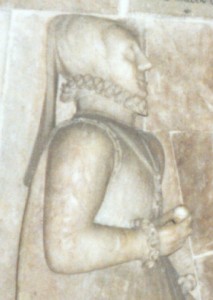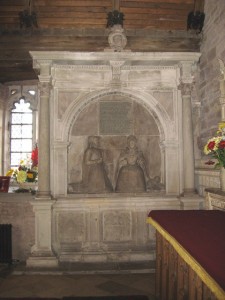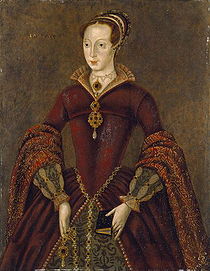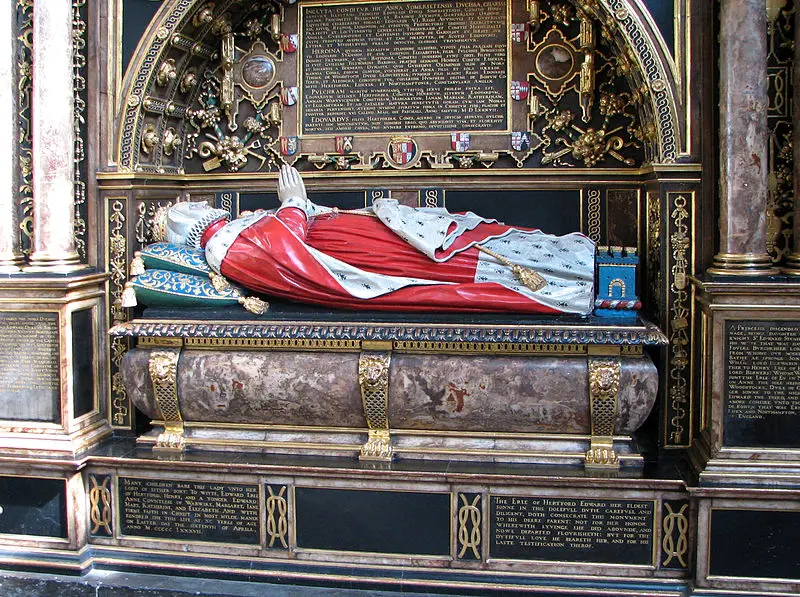
Detail of Blanche Parry's effigy from Bacton Church
As today is the anniversary of the death of eighty-two year-old Blanche Parry, chief Gentlewoman of the Privy Chamber, on 12 February 1590, I thought I would share an article written by Sarah Rochel back in 2009 for The Elizabeth Files.
Imagine being born into a royal family, but having a father who had killed your mother when you were less than three years old. Imagine that as you grew to adulthood in that lonely, dangerous world a woman existed who you had known since childhood and who had been at your side, your servant and guide ever since you could remember. That woman was with you through many a crisis, supported you while you were imprisoned in the Tower of London, and stuck with you through thick and thin until you became Queen.
That was the position Elizabeth found herself in, as many of us who study our history well-know. What is not so well know is that this very same woman, remained with Elizabeth after her coronation in 1559. She stayed at her side, tended to her needs, read and conversed with her, played music with her, hunted and dined with her - and laughed and gossiped with her on a daily basis, too, for the next forty-two years of her life. That woman’s name was Blanche Parry, chief Gentlewoman of the Privy Chamber, Keeper of the Queen Jewels and Furs and Keeper of The Queens Books – Elizabeth’s steadfast companion and confidante.
Mistress Blanche was born in Wales in either 1507 or 08. Now part of the modern United Kingdom, Wales still retains its own unique language and national culture. Blanche’s family - referred to in no less than nine ancient Welsh bardic poems - were prominent gentry of the border country between this part of the world and England and were related to the Herbert family and the Earls of Pembroke. Blanche’s father was Steward of the Cistercian Dore Abbey and was also Sheriff of Herefordshire. She, along with her sisters, most likely received their education from the nuns of nearby Aconbury - though there are also strong indications of earlier connections to the Lollards - an early form of Protestantism.
Blanche came to court during the reign of Henry VIII. In her epitaph she stated that she saw the young Elizabeth rocked in her cradle. This would have been around the year 1533 or 1534. Shortly afterwards she became involved with the welfare of the young princess and in the day to day affairs of the Privy Chamber - initially in tandem with Kat Ashley (governess and First Lady of the Bedchamber). Blanche was bilingual in Welsh and English and it is thought that she taught the young Elizabeth Welsh also.
Blanche never married, she remained devoted to Elizabeth all her life. She became, after the coronation, what today we would call a personal assistant to the Queen. She was always in attendance, governing the busy daily activities of the Privy Chamber at court. She passed on information to and from the Queen, she received gifts on behalf of the Queen and she was also sometimes a channel for requests and parliamentary bills. It was a position of immense responsibility and one which demanded the greatest integrity, intelligence and honesty. That she performed these duties for so many decades of faithful service is astonishing – an achievement matched only by those of her close cousin William Cecil, Chief Minister of State in Elizabeth’s Council for much of his life, also.
Blanche would have been in charge of many of the intimate daily routines of the Queen’s life. Dressing, toilet, washing, grooming and coordinating the correct gowns, jewels and furs for formal occasions. She would have been involved in organising entertainments and diversions, including music, plays and masques – all of which were regular features of life in the Privy Chambers of Court. And finally she would have slept in the queens Bedchamber at the close of each day – a place where, oddly it might seem to us, Elizabeth would often receive special close friends and privy councillors late into the night.
Blanche’s salary was very generous. At one time it is recorded as being set at £33 6s. 8d (compare this to the annual salary at the time of a typical maidservant's at the time, which was around just £3 per annum). Blanche also would have automatically received meals, clothing and accommodation for herself and her own servants in the luxurious rooms of the great royal palaces occupied by the Queen as she and the court moved from place to place – and she was also provided with stabling and feed for her own horses. Letters and documents of the times describe Blanche in a pivotal role about court: the accepted and acknowledged 'go-between' for anyone seeking the Queen's ear. Often she would be found at the doorway to the privy chambers, or else close to her Queen’ person, watching all the comings and goings of ladies and courtiers, accomplished and certain in her role, in command of all she surveyed.
If I could go back in a time capsule and meet with one person from history it would be Blanche. Here is a woman who was present at virtually every stage of Elizabeth’s amazing career – from the Northern Rebellion of 1559 to the Spanish Armada of 1588, present during the young Queen's near-death from smallpox in 1562 to her near-marriage to the French prince Alencon in 1581. She would have been privy to many of the regular late-night discussions among the Queen and her many favourites and suitors, and on intimate terms with luminaries such as Robert Dudley, Christopher Hatton, Walter Raleigh and Francis Drake. She would have seen it all at close quarters. What stories could she tell!
There exist still today two monuments to Blanche - one where she was laid to rest, in St. Margaret's Church, close to Westminster Abbey and also another in St Faith's Church in Bacton, Herefordshire where she had intended to be buried. The Bacton memorial shows her kneeling in prayer alongside an effigy of her Queen and has the inscription: ‘With maiden Queen a maid did end my life.’

The empty tomb of Blanche Parry at Bacton
For anybody wishing to learn more about Blanche, the following recent biography is recommended: "Mistress Blanche, Elizabeth I’s Confidante" by Ruth E. Richardson.
By Rochie



Love your postings, so informative.
Wish there was an easier wa to read about her & the relationship w/ the Queen
I am just starting to research Blanche Parry, her family and their descendants to see if there is a link to my own family who are from the south and west of Shrewsbury.
I also believe there may be a stained glass window in a church at Albury, near Shrewsbury that was moved from St Faith’s church in Bacton to Albury in the early 18th Century by the then vicars wife (Gittins?)
If anyone has further information to help me research if there is a link from the Parry’s of Bacton to the Parry’s of Shrewsbury, please do let me know.
Thank you
Sophia Parry
I thought that Blanche lost her place by Elizabeth’s bedside when Kat Ashley took over. Also, where was she when Elizabeth was in Katherine Parr’s household after Henry VIII’s death?